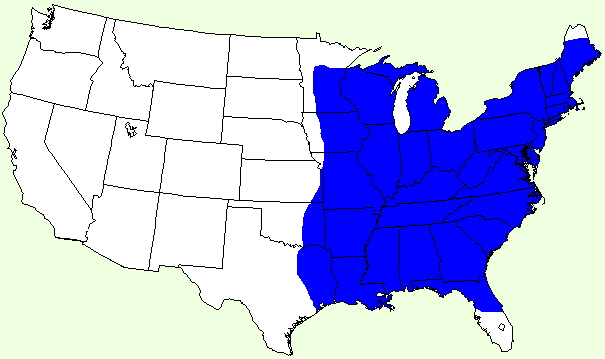Descriptive Qualities:
Range:
The Promethea moth is found in the eastern half of the US. From mid-Texas to Florida to Maine to Minnesota.
Map of this moth's Area:

Eggs and Larva
Depending on particular size of the moth, approximately 150 - 250 per female. When Promethea larva first hatch, they look much like a Cynthia caterpillar. They are brownish looking, and appear to have stripes. They stay this way until 3rd instar, at which point they turn white, with yellow tuberacles. Then in 4th and 5th instar they are white with 4 red tuberacles in their front, and 1 yellow tuberacle on their back. Promethea are highly gregarious in 1st and 2nd instars, becoming solitary from 3rd on.
Scenting and Mating
Female Prometheas put their scent out between 4:30 and 8:00 P.M. (One of few silk moths that fly during the day.) Males may come in at any time during this period. This moth makes it much easier on you, since their mating time is during the day, when most people are awake, you can easily watch them and put any males that may come in in with the females. But if it is still not possible for you to watch them that closely, use a cage with holes (about 1/2 to 3/4) so that the males that come in may mate with the female right through the cage. Promethea moths mate readily in captivity.
Cocoons
Promethea larva make very strong cocoons that hang on the branch of the trees they are feeding on. They sometimes move further down the tree, close to the ground, to make their cocoon, but almost never make them on the ground. Promethea's have 2 brood in some of their area, but one in most of it, from May - August.
Personal Markings or Characteristics
Promethea moths are dimorphic, which means male and female moths have different colorations. The male's wings are dark brown, appearing almost black, while the female's range from redish-brown to light brown (both are pictured in the photo album).
Caring For Prometheas, In All Stages:
Here are some notes that may be helpful when trying to raise Promethea larva, especially if it's your first time raising them.Caring for the eggs
To care for Promethea eggs, just put them in a small container. It is best to be small, because the caterpillars like to crawl a lot when they first hatch, and if you put them in a bigger container, they will crawl away from the food you put in with them, and might not be able to get back. That's a lot of area for such a small caterpillar.
Food Plants
Here is a list of all food plants that I have ever used to raise Prometheas on. In the odd occurance that you can not come by any of these, you should contact me. Experimenting with other foodplants could prove worthwhile.
* I have attempted to use Norway Maple to feed Prometheas, however, they usually died shortly after, so this may not be the best choice.
Raising the Larva (Inside)
Promethea larva are fairly easy to raise inside. I find it is easiest and beneficial to have them in a cottage cheese size container until about 2nd or 3rd instar, and then I move them to a ice cream bucket or a five gallon bucket for their last few instars. Prometheas, in most cases, are extremely touchy, you should not touch them often, or at all if possible. You should just feed them when they need food, and leave them be at any other time. But make sure they always have fresh food, as they tend to languish and die if they do not have fresh!
Raising the Larva (Outside)
Promethea larva are very easy to raise outside. You just find a suitable host plant and put the larva on it. It is best to put them on a branch and then put the branch inside some sort of netting, so that they are protected from predators like insects, birds, and rodents. It is best to get them started outside in nets as soon as possible, best to start them in 1st instar. Not only is it a lot less work, but they do much better outside than inside.
Caring for the cocoons
Caring for Promethea cocoons is pretty simple. You should put them in an area where it is fairly moist, if the cocoons dry out, they will die. If you just put them outside they should be fine. You cannot leave them inside, because they will hatch, but you can keep them in the refridgerator. If you do this, it is best to spray the cocoons with a light mist every once in a while so they don't dry out.
Return to Index.